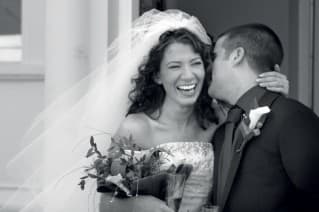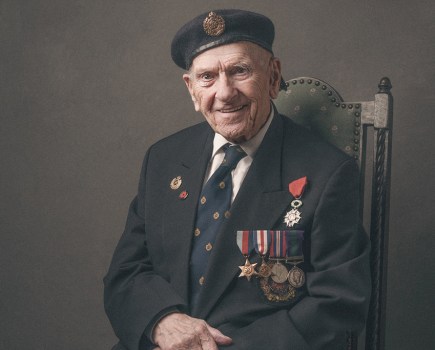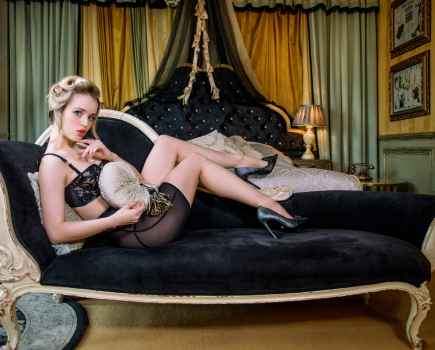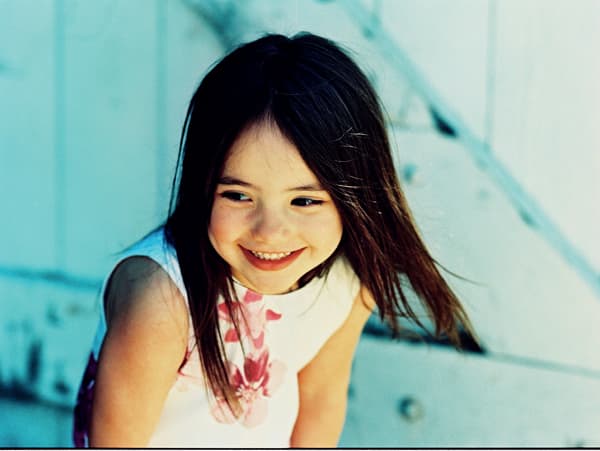
If one person can be credited with dragging commercial portraiture away from the purgatory of canvas backgrounds and gold-rimmed brown slip folders, it’s Annabel Williams. Now one of the UK’s most successful social photographers, the contemporary style she pioneered has now become almost mainstream, vindicating her years of battling against the staid conventions of the photographic establishment.
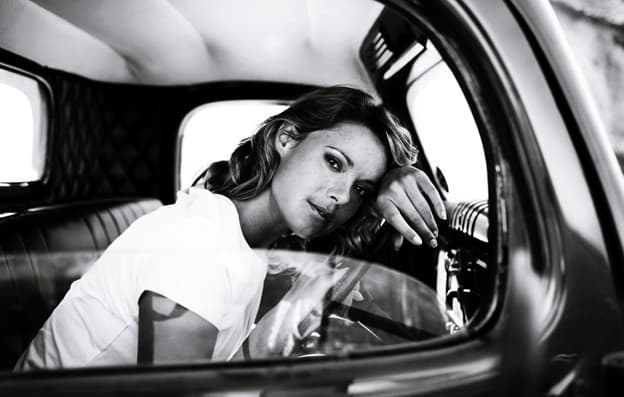 Her style is often called ‘lifestyle’ portraiture, which is a term she’s happy to be associated with, though she also describes it as ‘fashion photography for ordinary people’.
Her style is often called ‘lifestyle’ portraiture, which is a term she’s happy to be associated with, though she also describes it as ‘fashion photography for ordinary people’.
‘When I started out, there were only two ways women could be photographed,’ Annabel recalls. ‘You either looked like your mother, with a string of pearls round your neck, or you took your clothes off.’ Realising instinctively that women wanted to look glamorous and beautiful, like the models they admired in the glossy magazines, Annabel co-founded Cover Girl in the 1980s with her make-up artist sister, and it became a runaway success.
‘In effect, we invented makeover photography,’ she adds, ‘and of course since then it’s been widely copied.’ The style, however, has evolved. ‘Back in the Eighties it was about big hair, make-up and big shoulder pads because that was the look then. Now the look is more natural, but just as much work goes into styling.’
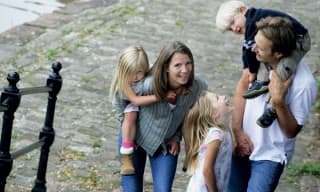 Annabel’s service is a million miles from the half-hour session down at the local studio. It’s a totally bespoke service, which starts way before the event with a detailed consultation and includes a full-day shoot at the client’s home (which often extends to favourite haunts and walks in the area) and even covers shooting a tailor-made portrait for a specific space in the client’s home, with clothes and backgrounds chosen to complement the décor. ‘I’m not just there to take their portrait,’ she insists. ‘I’m there to take the best portraits they’ve ever had.’
Annabel’s service is a million miles from the half-hour session down at the local studio. It’s a totally bespoke service, which starts way before the event with a detailed consultation and includes a full-day shoot at the client’s home (which often extends to favourite haunts and walks in the area) and even covers shooting a tailor-made portrait for a specific space in the client’s home, with clothes and backgrounds chosen to complement the décor. ‘I’m not just there to take their portrait,’ she insists. ‘I’m there to take the best portraits they’ve ever had.’
This approach obviously caters to the top end of the market, and Annabel travels far and wide from her Cumbrian base – Annabel was even flown over to Geneva to photograph one family, whose wedding she had done years before.
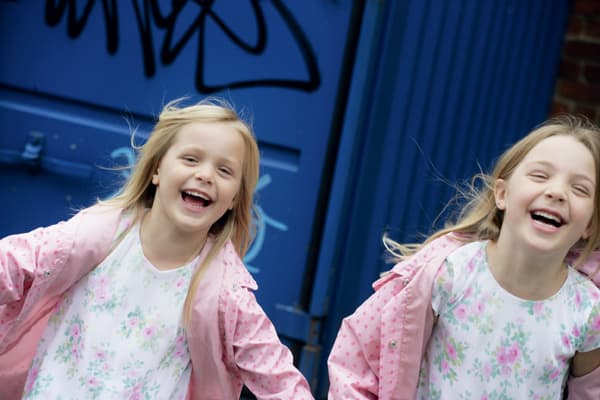
Despite owning a large, well-equipped studio in the Lake District, Annabel now shoots mainly on location, usually outdoors.
‘I used to prefer the studio because that was my comfort zone,’ she confesses. ‘I had the lights set up as I wanted, and was in control. Then I learned to work with natural light and now that’s all I use.’
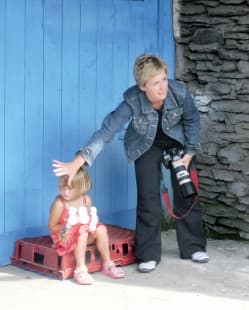 When Annabel arrives for a shoot, one of the first things she does is take a look around to find three or four different locations to do the shoot. ‘I look for where the light is good – nice and soft – and where there is an interesting background. Not necessarily picturesque; even a rusty tin shed can make a great background.’
When Annabel arrives for a shoot, one of the first things she does is take a look around to find three or four different locations to do the shoot. ‘I look for where the light is good – nice and soft – and where there is an interesting background. Not necessarily picturesque; even a rusty tin shed can make a great background.’
Annabel’s service includes a hair and make-up artist, and, while they’re making the client look beautiful, Annabel also goes through their wardrobes to pick out suitable outfits which will complement the settings she has chosen.
For the pictures themselves Annabel has long been an advocate of handheld 35mm SLRs, even when the norm was tripod-mounted medium format cameras. ‘How can you strike up a rapport with the subject when you’re looking down at an image on a screen which is back to front?’ she argues. ‘When I started out I was told to use a tripod but the pictures were just too static. There was no spontaneity.’
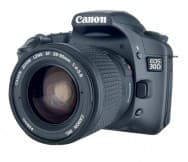 Annabel has been using the Canon EOS system for many years but only in the past couple has she gone digital. ‘I tried it before but the quality just wasn’t there for me, especially with the highlights, which used to blow easily. I suppose I was waiting for the cameras to become good enough for my needs.’
Annabel has been using the Canon EOS system for many years but only in the past couple has she gone digital. ‘I tried it before but the quality just wasn’t there for me, especially with the highlights, which used to blow easily. I suppose I was waiting for the cameras to become good enough for my needs.’
That moment came with the introduction of the EOS 1DS MkII and she now uses this camera exclusively, usually coupled with Canon’s 70-200mm f/2.8. ‘Although I have other lenses most of my portraits are done on this lens, because it’s less obtrusive and intimidating for the subject when I’m not right on top of them.’ It also helps that telephoto lenses have a flattering foreshortening effect on the perspective, too, with a pleasantly shallow depth of field.
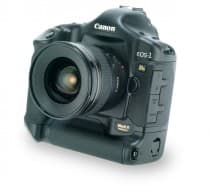 Annabel likes to shoot at f/5.6 as she finds it gives the best results, and she takes a selective meter reading off the subject’s face to ensure a correct exposure. To ensure a fast enough shutter speed to avoid camera shake she sets the camera to ISO 400 as a default – though she will go up to ISO 800 if necessary. ‘There’s little noise at 400 and it’s still acceptable at 800,’ she says.
Annabel likes to shoot at f/5.6 as she finds it gives the best results, and she takes a selective meter reading off the subject’s face to ensure a correct exposure. To ensure a fast enough shutter speed to avoid camera shake she sets the camera to ISO 400 as a default – though she will go up to ISO 800 if necessary. ‘There’s little noise at 400 and it’s still acceptable at 800,’ she says.
If there’s one word to describe Annabel’s style it would be informal. There’s none of the painstaking and pedantic posing that some photographers insist upon.
‘Actually I don’t pose people, I compose them,’ she insists. ‘There’s a difference. People need to feel comfortable in their space. If you pose them they become self conscious and look uncomfortable. I just ask them to sit down or lean against something. The position they take of their own accord will invariably be the one that produces the most natural pictures. I’ll just tidy up the edges here and there if need be.’
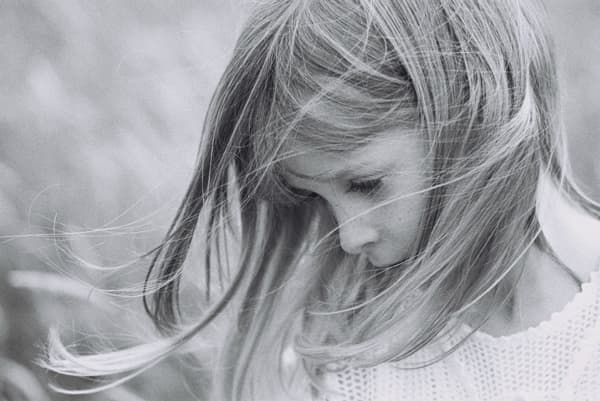 From here on it’s all about rapport, and making the session fun. ‘I want the day to be an unforgettable experience. I want my pictures to be about living life and enjoying it. Too many photographers are focused more on the equipment than the subject, and aren’t tuned in to their emotions. They don’t understand that it’s how a woman feels in a dress, not how she looks in it, that’s important.’
From here on it’s all about rapport, and making the session fun. ‘I want the day to be an unforgettable experience. I want my pictures to be about living life and enjoying it. Too many photographers are focused more on the equipment than the subject, and aren’t tuned in to their emotions. They don’t understand that it’s how a woman feels in a dress, not how she looks in it, that’s important.’
It seems that Annabel’s gender has been a big advantage to her in her career, because men, on the whole, are perhaps less well equipped to sense such things. ‘Actually some men are very in touch with their emotional side,’ she counters, ‘but too many are not, which is a handicap in this business. You have to be able to connect with people. Portrait photography is 90% psychology and 10% technology.’
One group of people that Annabel connects especially well with is children. Having worked with children in her previous career she instinctively knows how to get them onside. ‘The way you behave in the first five minutes determines their behaviour for the rest of the day. If they come in clinging to mum I can see they’re shy so I ignore them. Sooner or later their curiosity gets the better of them and they come round.’ Rather than just having them sit and look at the camera Annabel often gives children an activity to do, whether it’s sitting on a bike or picking up and throwing leaves at the camera. This makes the session more fun and produces more natural pictures.
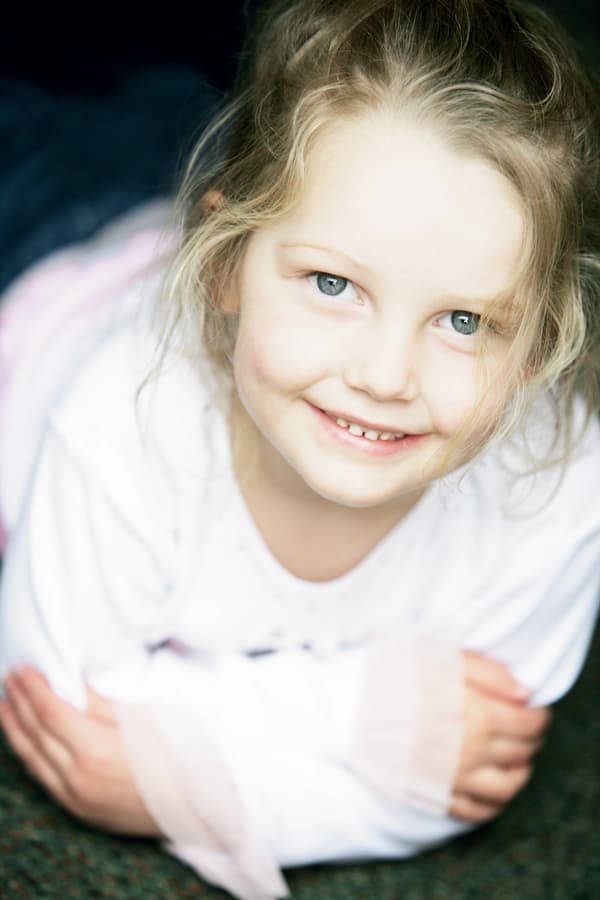 Whatever the age of the subject Annabel typically takes around 200 pictures during a shoot. She never uses flash, but has learned to find the best light just by her positioning of the subject. ‘Flash is a cop-out,’ contends Annabel. ‘You may get more light but it will look horrible and the client probably won’t buy the picture, because flash just isn’t flattering.’
Whatever the age of the subject Annabel typically takes around 200 pictures during a shoot. She never uses flash, but has learned to find the best light just by her positioning of the subject. ‘Flash is a cop-out,’ contends Annabel. ‘You may get more light but it will look horrible and the client probably won’t buy the picture, because flash just isn’t flattering.’
Back at her studio the next big job is the post production. ‘People say that digital saves money but that’s a myth, at least in my field,’ argues Annabel. ‘What you save on film you spend on time at the PC. I actually pay someone else to do that because otherwise I’d never be out shooting or getting new business, and that’s a mistake many photographers make,’ she says.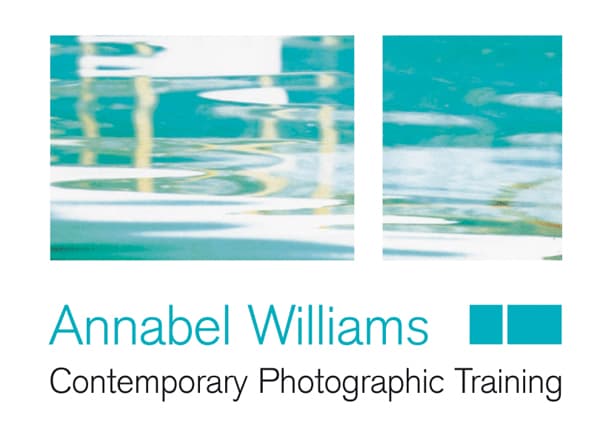
She should know because Annabel also has a busy second career as a teacher and trainer. Her company Contemporary Training runs courses and seminars for pro’s and anyone with an interest in photographing people. Among the topics that delegates do not learn are how to pose subjects as though they’re still lifes, how to blind them with flash, and how to ignore them while you fiddle about with your camera. WDC
Annabel Williams Top Tips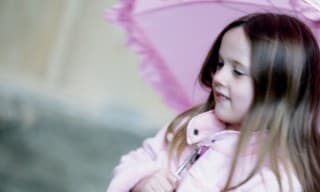
•Striking a rapport with the subject is essential. Be friendly, have fun.
•Don’t be intimidated by your gear. Learn it so it’s second nature, so you can concentrate on the subject.
•Use natural light. If you learn to see and use it well you’ll get much more natural results.
•Don’t ‘pose’ your subject. Go for natural poses and genuine expressions.
•Use a longer lens and stand further back. Getting right up close can be intimidating.
Annabel Willians on Weddings
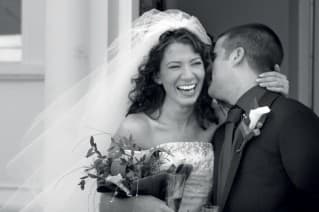 Annabel’s photography career began when she was asked to shoot a wedding when she was 25. She tries to capture the spirit and joy of the event, rather than going for static posed shots. But she rejects the trendy ‘reportage’ style. ‘You still have to manage the shoot,’ she insists,’ because if you just shoot candids the chances of getting shots with everyone looking good are almost zero. You have to direct things, but show the joy and emotion of the event.’ Perhaps ‘contrived spontaneity’ is a better term for it.
Annabel’s photography career began when she was asked to shoot a wedding when she was 25. She tries to capture the spirit and joy of the event, rather than going for static posed shots. But she rejects the trendy ‘reportage’ style. ‘You still have to manage the shoot,’ she insists,’ because if you just shoot candids the chances of getting shots with everyone looking good are almost zero. You have to direct things, but show the joy and emotion of the event.’ Perhaps ‘contrived spontaneity’ is a better term for it.
Annabel Williams Top Gear
Annabel uses a Canon EOS 1DS MkII, usually with a 70-200mm f/.2.8, but sometimes a 28-80mm f/2.8. She doesn’t use flash, tripods, reflectors or any other accessories, but does take a hair and make-up artist
to make sure her subjects look their best.
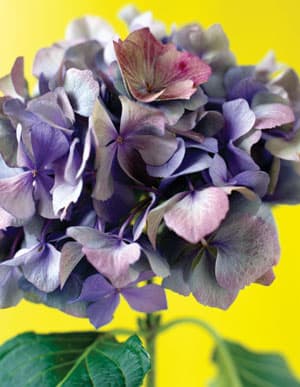 8. Colour Confidence
8. Colour Confidence
A colour wheel or circle is traditionally used in the field of art and provides a useful guide for creating colour harmony. Colour harmony creates visual interest and a sense of order. When something is not harmonious, it looks either boring or chaotic.
One way of creating harmony is by using complementary colours. This is any two colours which are directly opposite each other on the wheel, such as red and green and red-purple and yellow-green. Opposing colours, like this purple and yellow composition shown here, create maximum contrast and make a bold statement.
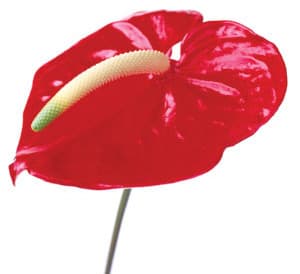 9. White Background
9. White Background
Achieving a clean white background is one of the ultimate tests for a floral still-life photographer. In the northern hemisphere the cool colour temperature of the light creates a blue cast. This is more noticeable in images that have white as the predominant colour.
Fortunately, digital cameras allow us to vary the colour balances and, to some extent, the contrast or dynamic range. The best way to achieve a correct white balance is to use the Custom or Manual white balance mode.
By simply pointing the camera to a sheet of white A4 paper under the lighting conditions you are working in, a proper balance of colours can be set. Be careful not to underexpose your image as this will result in a grey rather than white background. Shooting in Raw format will allow you to make all these adjustments to the images at the post-production stage.
10. Sympathetic Lighting
Controlling your lighting is key to producing a successful image. Think about what kind of lighting would complement your subject and choice of background. Lighting from the side, for example, throws long shadows and enhances rough textures. If you have a translucent subject or one with a strong graphic shape you may want to backlight it.
For soft, even light such as this try window light on an overcast day, but enhance it with silver reflectors otherwise it will be too flat. During the winter months gold reflectors will warm the colder colour temperature.
(All Images by Emma Peios)

